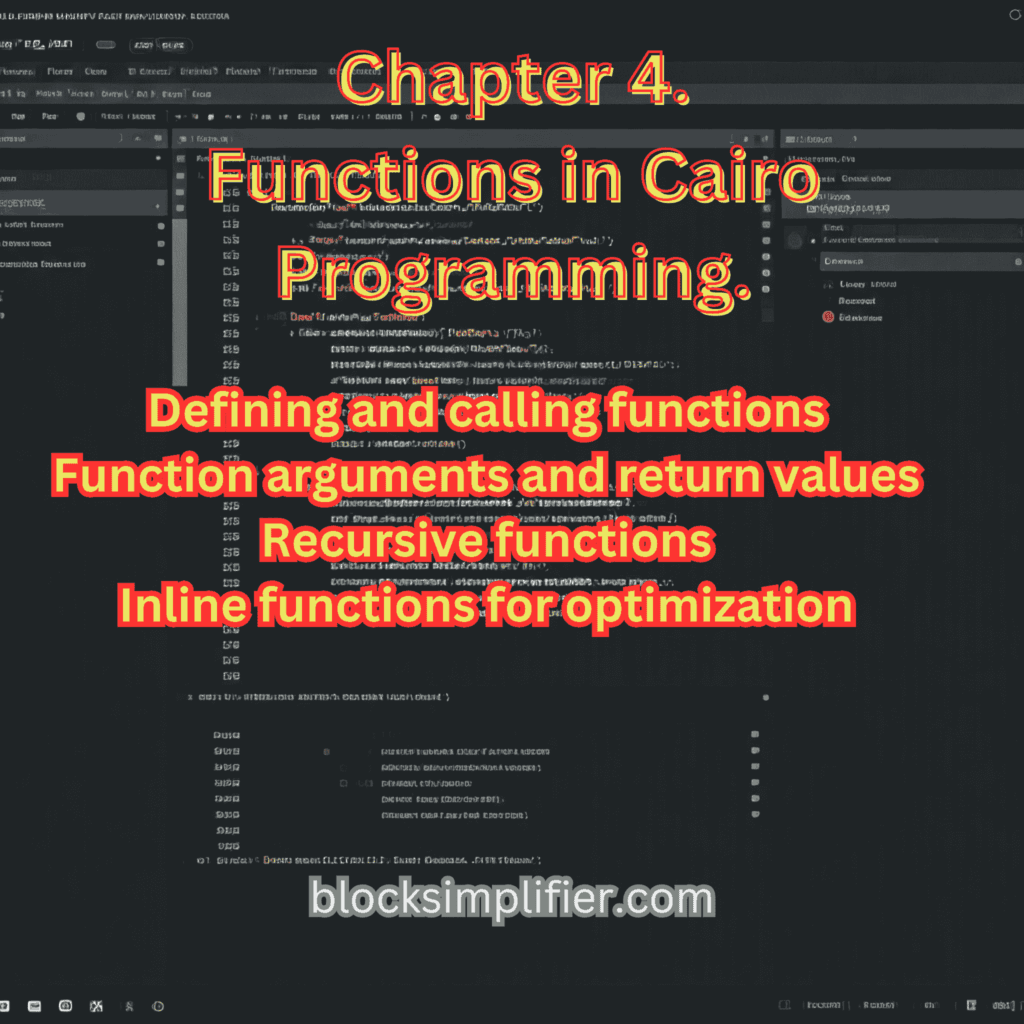In Cairo, functions are crucial for code organization and reuse. They encapsulate a specific piece of logic, making your code more modular, readable, and maintainable.
Table of Contents
Defining and Calling Functions in Cairo
In Cairo, a function is a self-contained code segment created to execute a specific task, promoting modularity, readability, and code reuse.
Defining a Function:
- Syntax:
func function_name(arg1: felt, arg2: felt) -> felt {
# Function body
let result = arg1 + arg2;
return result;
}
- Explanation:
funckeyword: This signifies the start of a function definition.function_name: This identifies the function in a unique manner.arg1: felt,arg2: felt: These are the function’s parameters, along with their data types (in this case,felt).-> felt: This specifies the return type of the function.- Function body: This is where the code to be executed within the function is placed.
- A function uses the
returnstatement to output a value.
Calling a Function:
- Syntax:
func main() -> felt {
let result = function_name(5, 3);
return result;
}
- Explanation:
- A feature is referred to as by writing its call and setting the arguments internal parentheses.
- The arguments supplied should in shape the kinds of the parameters defined inside the characteristic’s signature.
Example:
Code snippet
func add_numbers(a: felt, b: felt) -> felt {
return a + b;
}
func main() -> felt {
let sum = add_numbers(10, 5);
return sum;
}
In this example:
- The
add_numbersfunction is defined, taking twofeltarguments (aandb) and returning their sum. - The
mainfunction callsadd_numberswith arguments 10 and 5. - The result of the
add_numbersfunction call (15) is stored in thesumvariable. - The
mainfunction returns the value ofsum.
Function Arguments and Return Values in Cairo
In Cairo, features can have interaction with the rest of your code through arguments and return values.
Arguments:
- Purpose: Arguments are values that you bypass right into a characteristic to offer it with the vital facts to perform its project.
- Declaration: When defining a feature, you specify its arguments in the parentheses following the characteristic call. Each argument has a call and a records kind.
func my_function(arg1: felt, arg2: felt) {
# Function body
}In this example, my_function takes two arguments: arg1 and arg2, both of type felt.
Passing Arguments: When you call a function, you provide the actual values for the arguments within the parentheses.
let result = my_function(5, 3);Here, the values 5 and 3 are passed as arguments to my_function.
Return Values:
- Purpose: A function can return a cost to the part of the code that referred to as it. This permits functions to provide effects that can be utilized in other components of your application.
- Declaration: The return type of a function is particular after the argument listing, the usage of the -> symbol.
func my_function(arg1: felt, arg2: felt) -> felt { # Function body return arg1 + arg2; } This function takes two felt arguments and returns a felt value.
Returning Values: The return statement is used to specify the value that the function should return.
let sum = my_function(10, 5); // sum will be 15 In this example, the my_function is called with arguments 10 and 5. The function returns their sum (15), which is then stored in the sum variable.
Key Points:
- Arguments can help you provide input to capabilities, making them extra flexible.
- Return values enable features to produce output that may be used in different components of your code.
- By using arguments and return values effectively, you can create modular and reusable functions that improve the structure and maintainability of your Cairo programs.
Recursive Functions in Cairo
In Cairo, recursive capabilities are a effective tool for solving issues that can be damaged down into smaller, self-similar subproblems.
Key Concepts:
- Definition: A recursive function is a function that calls itself inside its very own definition.
- A base case is vital for all recursive capabilities. It gives a situation that halts the recursion. Without a base case, the characteristic might preserve to name itself indefinitely, inflicting a stack overflow error.
- Recursive Step: The recursive step is where the characteristic calls itself with changed arguments, moving toward the base case.
Example: Factorial Function
func factorial(n: felt) -> felt {
if n == 0 {
return 1; // Base case: factorial of 0 is 1
} else {
return n * factorial(n - 1); // Recursive step
}
}
In this example:
- Base Case: If
nis 0, the function simply returns - Recursive Step: Otherwise, the function returns
nmultiplied by the factorial ofn-1, with this process repeating untilnreaches 0.
Important Considerations:
- Stack Overflow: Excessive recursion can result in a stack overflow error, as every recursive name consumes memory on the call stack.
- Tail Recursion: Cairo helps tail recursion optimization, which could help prevent stack overflows in certain cases. Tail recursion happens while the final operation in a characteristic is a recursive call to itself.
Example: Tail Recursive Factorial
func factorial_tail_recursive(n: felt, acc: felt) -> felt {
if n == 0 {
return acc;
} else {
return factorial_tail_recursive(n - 1, n * acc);
}
}
func factorial(n: felt) -> felt {
return factorial_tail_recursive(n, 1);
}
The function is tail recursive in this version because the recursive call is the last action.
When to Use Recursion:
- Issues that can be divided into smaller, repetitive subproblems.
- Trees and linked lists are examples of data structures.
- Techniques including depth-first search and divide-and-conquer algorithms.
Inline Functions for Optimization in Cairo
Inline functions are a technique used to potentially improve the performance of Cairo programs. Here’s a breakdown:
Concept:
- Traditional Function Calls: When you name a feature, the program’s execution waft jumps to the feature’s code, executes it, and then returns to the original region. This includes overhead like putting in the stack frame, passing arguments, and dealing with the return value.
- Inlining: The compiler at once embeds the code of the function at the decision site, keeping off the performance price of a function call.
Benefits:
- Potential Performance Improvement: By disposing of feature name overhead, inlining can result in quicker execution, specifically for small, often referred to as functions.
- Reduced Code Size (Sometimes): If the function is very small, inlining might result in a smaller overall code size, as the function’s code is duplicated at each call site instead of being stored separately.
Syntax:
- In Cairo, you can use the
@inlinableattribute to suggest to the compiler that a function should be inlined:
@inlinable
func my_inline_function(x: felt) -> felt {
return x * 2;
}
Important Considerations:
- Compiler Decisions: The compiler ultimately decides whether to inline a function based on various factors, including:
- Function size: Smaller functions are more prone to being inlined.
- Call Frequency: Frequently called functions are good candidates for inlining.
- Code Size: Inlining can growth code length, so the compiler attempts to stability overall performance profits with code length growth.
- Drawbacks:
- Increased Code Size: Excessive inlining can result in tremendous code bloat, potentially negating any performance gains.
- Reduced Readability: Inlining could make the code tougher to study and maintain, as the feature’s good judgment is scattered for the duration of the code.
- Compiler Directives: You can use compiler directives to influence inlining choices, however it’s usually satisfactory to permit the compiler make these choices.
Example:
@inlinable
func square(x: felt) -> felt {
return x * x;
}
func main() -> felt {
let result = square(5); // The compiler might inline the 'square' function here
return result;
}
In Summary:
Inline functions can be a useful optimization technique in Cairo, but use them judiciously. Consider the potential trade-offs between performance gains and code size/readability. The compiler’s inlining heuristics are typically effective, but you could use directives to provide steerage.
Frequently Asked Questions
- When to use inline functions?
- Small, frequently called functions are good candidates for inlining.
- Use discretion, as inlining can sometimes increase code size.
- How does the compiler decide if a characteristic have to be inlined?
- The compiler makes use of heuristics to decide if inlining may be useful.
- You can influence inlining choices by using compiler directives.
- What issues might arise when using inline functions?
- Overusing it can result in a larger codebase.
- Performance gains are not always a guaranteed outcome.
What are functions in Cairo?
- Functions are impartial sections of code designed to perform a specific challenge.
- They beautify code business enterprise, reusability, and clarity.
What are inline functions?
- A compiler optimization technique where the function’s code is directly inserted at the call site.
- Performance can be enhanced by minimizing function call overhead.
- Use
@inlinableattribute to suggest inlining.
When should I use inline functions?
- Small, frequently called functions are good candidates.
- Use with caution, as immoderate inlining can growth code length.
How does the compiler determine whether or not to inline a characteristic?
- Based on heuristics (function size, call frequency).
- Compiler directives can influence inlining decisions.
What are the drawbacks of inline functions?
- Can increase code size.
- May not always improve performance.
- Can reduce code readability.
What are some best practices for using functions in Cairo?
- Ensure functions are short and focused on a single purpose.
- Use descriptive function names.
- Consider using tail recursion for improved performance.
- Use inline functions judiciously.



Pingback: Chapter 5: Control flow in Cairo Programming - BlockSimplifier